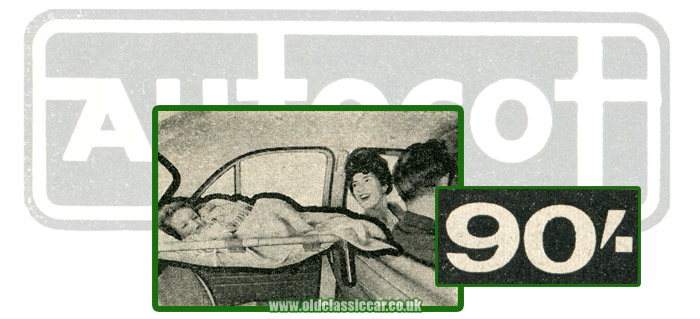The AUTOCOT - transport for children (or not).
Anyone with a baby or young child will be no doubt familiar with the minefield that is choosing a suitable car seat. Considerations such as which way around the child must face, depending on their age, is just one of many factors to consider, in addition to the presence or otherwise of airbags. To Isofix, or not to Isofix, with reference to how a child's seat is installed, is something that will usually depend on the vehicle being used. The child's weight and height also play their part in the decision process. Lots to think about indeed.
|
|
In the 1950s and 1960s, there seem to have been fewer worries when it came to the subject of occupant safety in the motor-car, although manufacturers were beginning to take notice of the subject. Cars began to lose sharp edges on the dashboard for instance, while pointy toggle switches were replaced by push-buttons, and interior handles became flusher. Some, notably Volvo, began to install seat belts and suitable mountings for seat belts, as standard in their cars.
|
|
Improving safety for the private owner-motorist therefore tended to focus on seat belts, which could be retro-fitted in many cases, and the type to choose. Inertia reel or static? Three-point or just a simple two-point lap belt? These were the questions that had to be answered, before improving adults' safety in the car in the event of a crash. What though to do with children, especially babies and toddlers? It was for this market that the AUTOCOT was designed, in addition to the camping and caravanning sectors which, I think, is where advertising for this frankly terrifying-looking car accessory should have remained.
|

|
|
No doubt on the typical car journey, such a contraption would have sufficed, but the thought of an un-restrained child lying in this hammock-type device, and the ease with which it could become airborne in even the mildest of impacts, isn't a cheerful one. Even books left on the rear parcel shelf can become deadly in the event of a shunt, and can easily break the neck of someone who happens to be sitting in the front of the car. The outcome after a bump with this arrangement, for both the child and front seat occupants, doesn't bear thinking about.
|
|
It would appear that the AUTOCOT was introduced early in 1960. Priced at 90 shillings, it offered, apparently, "safe and comfortable travelling for young children". If there were any provisions for restraint, they aren't mentioned.
|
|
Speak to anyone who travelled within cars as a child in this era, and most will recount trips made where the kids were free to roll around on the back seat at will, and the vast majority will not have come to harm. Indeed, this is the situation in most classic and vintage cars now, although most are not in daily use and tend to be driven quite gently for local jaunts, rather than ploughing up and down motorways, which were coming into vogue in 1960s' Britain.
|
|
Does anyone remember using an AUTOCOT? Was it as scary as it looks in this illustration? Different times I know, but could this really have been advertised as an accessory to improve (junior) passenger safety?
|
|
Return to the gadgets, tools & accessories pages at oldclassiccar.
|





